Not just one but a regiment of smooth agaves, A. desmettiana in bloom, a dynamic but also hauntingly melancholy sight.
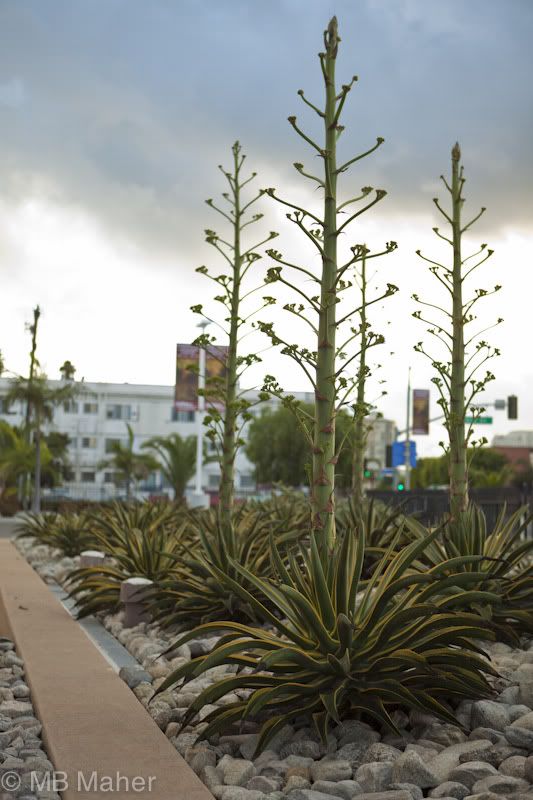
As we agavephiles know all too well, flowering heralds their death, the definition of monocarpic.
I wonder if the Museum of Latin American Art knows that the jig is up on a large percentage of their fairly new landscaping.
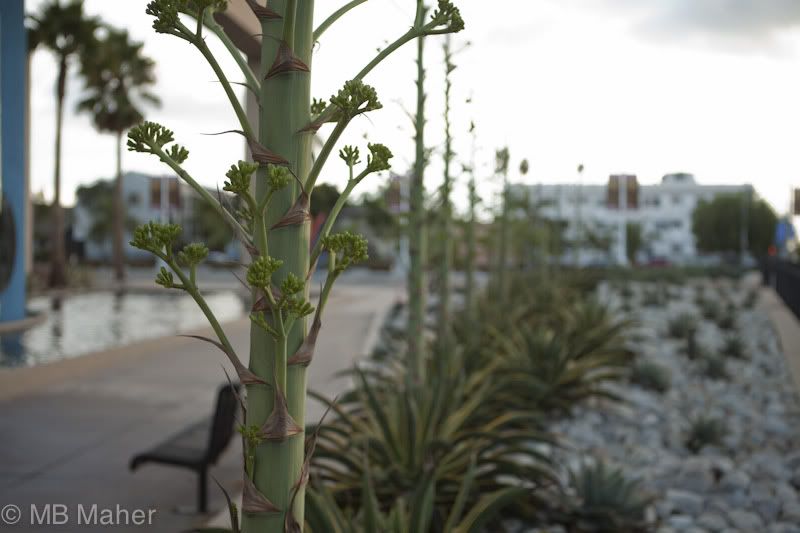
“Smooth” refers to this agave’s lack of barbed leaves, having just the one terminal central spike.
I’ve been watching these blooming agaves at this nearby museum since before summer, scanning for signs of their inevitable descent into decrepitude, which can take up to a year once flowering begins. Knowing their days are numbered, I asked MB Maher to swing by MOLAA earlier in the week to grab some photos while they still radiated vigor, piercing the sky with bloom spikes over 6 feet in height. This landscaping was installed approximately 2007, and the smooth agave blooms after approximately ten years of age, so it seems pretty clear that large, mature agaves were chosen for maximal visual impact. There’s also cactus and aloes, Aloe striata just visible in this photo.
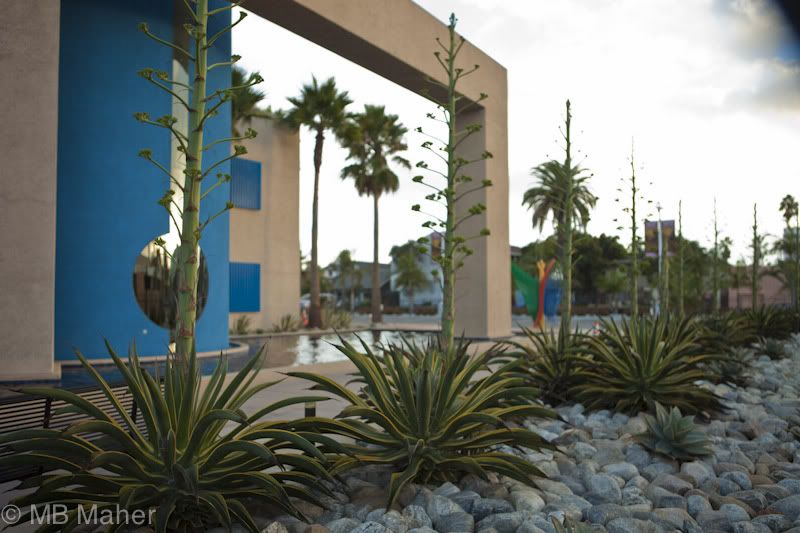
Due to a pressing pre-holiday workload, I wasn’t able to physically leave the office to gadabout taking photos of agaves in their death spiral, but that doesn’t preclude extended bouts of procrastination at my desk, hitting on nearly every A. desmettiana link in cyberspace. I tumbled into cyber rabbit hole after spider hole after rat hole, found some truly odd home videos people made about their agaves, discovered some astounding Dutch agave porn, but little useful content and much of it contradictory.
But I am now in possession of the following facts (and sharing them makes me less a procrastinator and more a researcher, doesn’t it?):
1) Agaves striata and bracteosa are some of the few agaves that don’t die after flowering. A relief to learn my little A. bracteosa may have a long life still ahead of him. I say may because it’s also reputed to be monocarpic by many sites. (Typical of Internet research, gathering information is like building on quicksand.)
2) Agave desmettiana, one “t,” is the preferred but less widely used spelling, in that the agave is named for Louis De Smet (1813-1887), a Belgian horticulturist and nurseryman.
3) Agave desmettiana cannot be reproduced from seed, only offsets. (On this blog’s All My Agaves post, I erroneously referred to mine as seed-grown, which is how they were labeled at the nursery.)
4) A study on nectar-feeding bats in Colombia found that this agave produced more pollen and 10 times more nectar than other plants visited, so its flowering is a feast for wildlife.
5) A. desmettiana may be an ancient cultivar, possibly derived from A. sisalana or A. kewensis Jacobi (the Flora of North America). Possibly originated in tropical and subtropical Mexico. There are no sightings of this agave in the wild but it has been in cultivation for centuries. The canard persists about all specimens coming from only Pre-Columbian sites. Personally, I’d love to believe Chichen Itza was once studded with this agave.
As moving as this spectacle of dying agaves is, I’m already wondering what they’ll plant in their place. For a replacement, high-impact agave, maybe the salmiana hybrid ‘Mr. Ripple,’ which doesn’t offset too obnoxiously and grows large enough to be effective in this huge space. But it does lack variegation. The variegated americanas, though large, produce way too many offsets. Maybe a variegated attenuata? More procrastinating research is in order to find the perfect landscape agave.
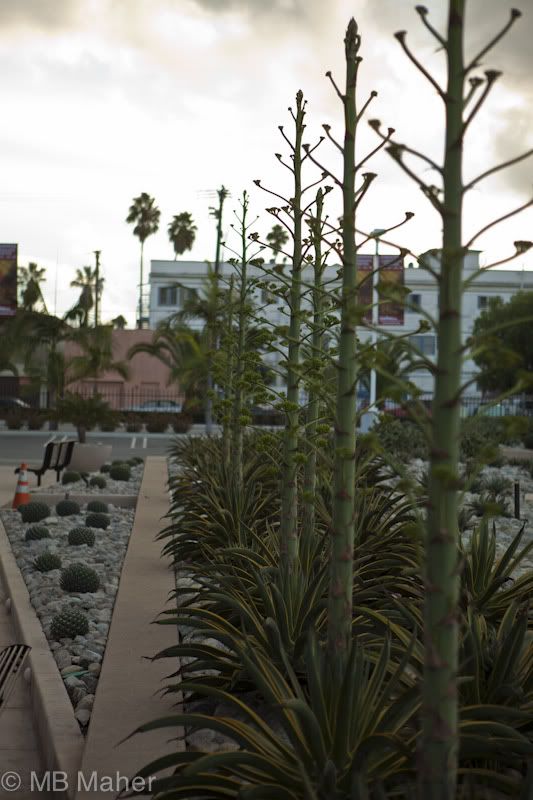
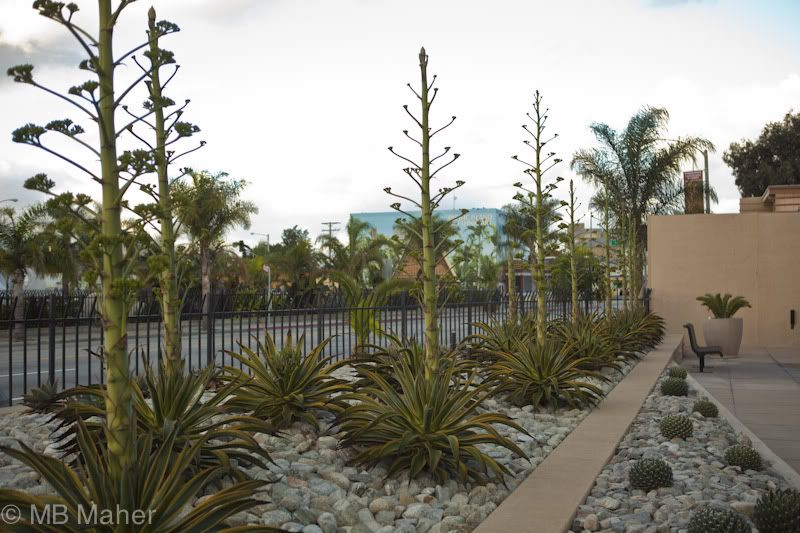
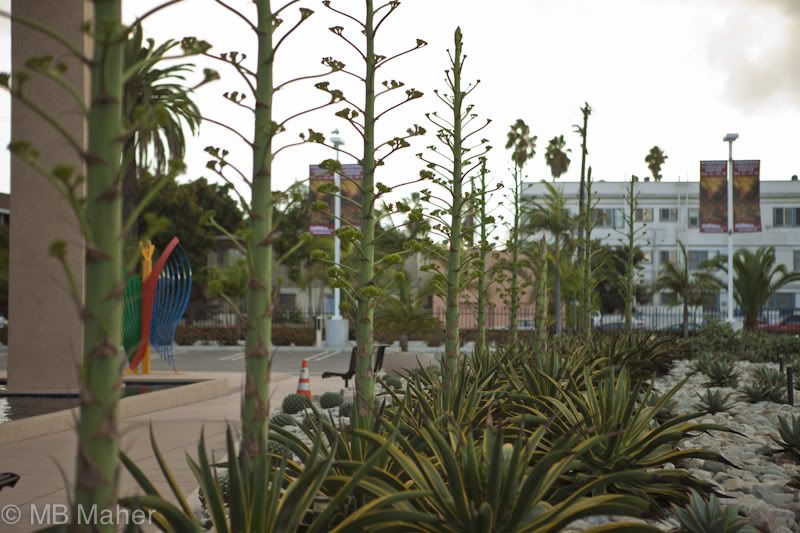

Hmmm, thank you for this little bit of Agave photo bliss on a cool November morning. And interesting to hear that Agaves striata and bracteosa may not be monocarpic, I’ve never read this and will have to do a little research myself.
I support your research project..better that than the mall !
By offset you mean both both pups and bulbils, right? Not death, really–dozens of pups and thousands–seriously, thousands–of bulbils soon enough. Agave have the magic of the mythical Phoenix: in death, they are reborn.
Lovely photos!
You’re welcome, Loree — we’re having a record cold snap but not into frost territory yet.
Kathy, I shudder at the thought!
Hoov, that’s true, offsets and bulbils, but this whole landscape will have to be redone, can’t restart a space this size with offsets. I was tempted to mention your ‘Joe Hoak’ in this piece but there’s some opinion that he’s a different species so left it out. What a bottomless pit agave literature is…
It’s going to cost a lot to replace all those agaves. Seems like a short-sighted decision to have planted mature ones. Cool pics though.
What an incredible statement those agaves make. Even though they die there is nothing so majestic as when they are in bloom, They deserve their moment. I heard tell from a friend that a landscaper had cut off the flowering stalk and told her it was to stop the plant dying. I researched it at the time and learnt that the chemical which induces flowering also results in death. Wouldn’t that look ugly to cut the stalk! I have A. desmettiana here, but it never gets to live to be 10 years. It pups profusely and I pot them up and save them through the winter and replant them outside. They grow at a prodigious rate when given better soil and some water. We have seen amazing flowering of agaves in Austin this year. Must have been the cold winter followed by lots of moisture. It was like they said, “Right lads, lets get propagating right now” I wonder if those are offsets on the flower stalk and that is another way they reproduce.
Denise, these photos are fantastic! As a former LB resident (30+ years) I miss MOLAA being just a few blocks away … btw: love how much more tan I appear on your blog! LOL
I noticed that the Getty was replacing their A. americana plants in their gonzo agave planting now that the plants have bloomed. It looks like the way most agaves are used in the landscape–lots of similarly-size plants, often in geometrical arrangements–isn’t a practical or sustainable option. But more informal drifts of them in different sizes might accommodate how they really grow.
I hope you will be heading back, or at least sending your photography crew to get some pictures as the flowers open, if the bats will allow it. Perhaps there will be some pups at the base to take over when the mother plant dies. My favorite shot is the last one.